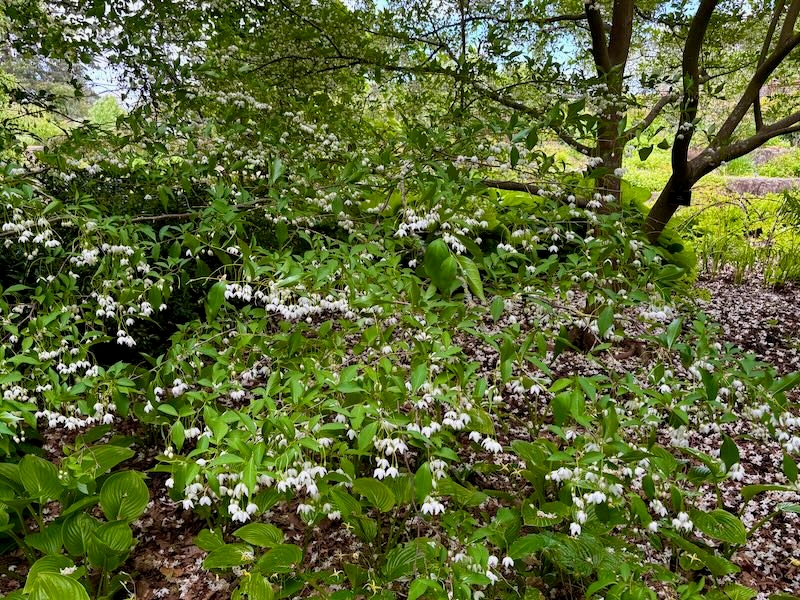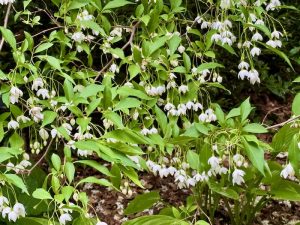Styrax japonicus: The Graceful Japanese Snowbell Tree
A symbol of grace and tranquility in the landscape, Styrax japonicus, commonly known as the Japanese Snowbell, is a refined flowering tree. They cherish this tree for its delicate bell-shaped blossoms and gentle presence in the garden. Native to Japan, Korea, and southern China, this deciduous tree embodies elegance with its pendulous white flowers, horizontal branching structure, and subtle seasonal interest. Use it in woodland borders, sloped plantings, or refined patio gardens, Japanese Snowbell deserves a place wherever understated beauty is valued.
Botanical Identity and Origins
Styrax japonicus is part of the Styracaceae family and is the most popular species in its genus. The Latin epithet japonicus reflects the tree’s Japanese origin. The common Japanese name “egonoki” refers to the fruit’s bitter taste, once considered repulsive to the tongue. Gardeners value this tree for its ornamental beauty ever since plant explorer Richard Oldham introduced it to Western gardens in the 1860s.
This species is found in diverse environments across East Asia. It thrives in temperate zones, being hardy from USDA Zones 5 through 9. It has even gained favor in urban gardens due to its tolerance of air pollution and resistance to pests and diseases.
A Visual Masterpiece Through the Seasons
At maturity, Styrax japonicus typically reaches 20 to 30 feet (6 to 9 meters) in height and width, though some specimens may grow taller under ideal conditions. Its growth rate is moderate, and it develops a rounded, spreading canopy, often beginning with a vase-shaped habit in youth and maturing into a more horizontal, tiered form.
From late spring to early summer, the tree drips with hundreds of slightly fragrant, bell-shaped white flowers that dangle in racemes from horizontal branches. These blooms, about 2–3 cm (¾–1 inch) long, are set beneath the foliage, making them easily visible and admired from below—an ideal feature for planting beside a bench or pathway where their beauty can be appreciated at eye level or above.
The leaves are glossy, dark green, and oblong, arranged alternately. In autumn, foliage may transition to warm tones of yellow, gold, or red, depending on environmental conditions, adding a gentle burst of fall color. The bark, another ornamental asset, reveals interlaced orange-brown fissures as it matures, offering winter appeal even when the branches are bare.
The tree’s fruit is a dry drupe, olive-like in appearance, gray-green in color, and under an inch long. These often persist into autumn and are of little ornamental value, though they add a touch of textural interest and have historical uses in Asian cultures.
Cultural Uses and Folklore of Styrax japonicus
The wood of Styrax japonicus is famously dense and strong, historically employed to make umbrella ribs, walking sticks, prayer beads, and game pieces for shogi, a traditional Japanese board game. The saponin-rich pericarp of its fruit was once used to make soap and even utilized in traditional East Asian fishing methods to stun fish. This tree is more than just ornamental—it has been culturally and practically significant across generations.
Medicinally, extracts from various parts of the plant have shown antibacterial, analgesic, and hypoglycemic properties. Compounds such as egosaponin and kaempferol derivatives have been investigated for their therapeutic potential, though the tree remains primarily a landscape ornamental in Western cultivation.
How to Grow Styrax japonicus
Light
Japanese Snowbell prefers full sun to partial shade. In warmer climates, filtered afternoon shade can help prevent heat stress. A site with 4–6 hours of direct sunlight daily will ensure optimal blooming.
Soil
This tree thrives in rich, well-drained, slightly acidic to neutral soil (pH 5.5–7.0). Amend heavy clay with compost, pine bark, or sand to improve drainage. Consistent moisture is key—Styrax japonicus is not drought-tolerant and resents dry, compacted soil.
Watering
Keep the soil evenly moist, particularly during establishment and dry spells. Avoid soggy conditions, but do not allow the root zone to dry out. Mulching with 2–3 inches (5–7.5 cm) of organic material helps maintain soil moisture and temperature.
Fertilizing
Feed in early spring with a balanced slow-release fertilizer, such as 10-10-10, or use compost to improve soil fertility. Avoid over-fertilizing, which can encourage excess foliage at the expense of flowers.
Pruning
Minimal pruning is required. Shape the tree lightly in late winter to remove any dead, broken, or crossing branches. Remove lower branches if a more tree-like form is desired, but preserve some horizontal branching to enhance the tree’s graceful character.
Pests and Diseases
Generally problem-free, Styrax japonicus is occasionally susceptible to ambrosia beetle in stressed trees. Ensuring proper siting and watering practices helps maintain vigor and prevent infestations. In high-pH soils, look out for chlorosis (yellowing of leaves) —this can be corrected by acidifying the soil.
Landscape Uses and Design Ideas
- Accent tree near patios, entryways, or garden benches
- Small groupings in naturalized borders or woodland edges
- Shade tree for underplantings of hostas, hellebores, and ferns
- Winter interest tree due to its unique bark and branch structure
Its pendulous blossoms make this tree particularly striking when viewed from below, so plant it near paths or open areas where visitors can pause and look up into its canopy. Give the tree adequate space to showcase its natural spreading form—avoid cramming it into overly tight spots.
Companion Plants
The refined aesthetic of Japanese Snowbell pairs beautifully with:
- Hydrangea macrophylla – adds bold summer blooms beneath its canopy
- Helleborus orientalis – ideal for shaded ground under its branches
- Kalmia latifolia – provides spring interest with contrasting form and texture
- Pieris japonica – an evergreen complement with red-tinged new growth
- Hosta cultivars – low-growing foliage accents for root shading and contrast
Propagation of Styrax japonicus
Propagation is typically done via seeds or softwood cuttings. Seeds require cold stratification. Cuttings taken in early summer root best under mist or in a humidity dome with bottom heat.
Notable Cultivars
- ‘Pink Chimes’: A pink-flowered cultivar that offers a rare twist on the classic white bloom.
- Benibana Group (Beniego): Encompasses cultivars with pink or rosy-hued flowers.
- ‘Evening Light’: Features deep burgundy foliage with white blooms.
Final Thoughts on Styrax japonicus
Graceful in structure and refined in bloom, Styrax japonicus embodies quiet beauty. It asks little of the gardener but gives generously in return: fragrant spring blossoms, pleasing architecture, and elegant foliage throughout the seasons. As long as its cultural needs—moist acidic soil and protection from drought—are met, this tree will thrive in temperate landscapes, adding charm and serenity to gardens large and small.
Whether planted as a single specimen or in a small grove, the Japanese Snowbell offers a timeless aesthetic rooted in its Eastern heritage and admired around the world.



